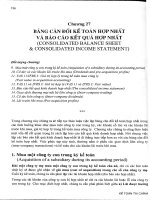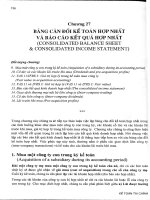Gíao trình kế toán bằng tiếng anh appendix a
Bạn đang xem bản rút gọn của tài liệu. Xem và tải ngay bản đầy đủ của tài liệu tại đây (964.38 KB, 48 trang )
Appendix A
Time Value
of Money
Learning Objectives
After studying this chapter, you should be able to:
A- 1
1.
Distinguish between simple and compound interest.
2.
Solve for future value of a single amount.
3.
Solve for future value of an annuity.
4.
Identify the variables fundamental to solving present value problems.
5.
Solve for present value of a single amount.
6.
Solve for present value of an annuity.
7.
Compute the present value of notes and bonds.
8.
Compute the present values in capital budgeting situations.
9.
Use a financial calculator to solve time value of money problems.
Basic Time Value Concepts
Time Value of Money
Would you rather receive $1,000 today or in a year
from now?
Today! “Interest Factor”
A- 2
Nature of Interest
Interest
Payment for the use of money.
Excess cash received or repaid over the amount borrowed
(principal).
Variables involved in financing transaction:
1. Principal (p) - Amount borrowed or invested.
2. Interest Rate (i) – An annual percentage.
3. Time (n) - The number of years or portion of a year that the
principal is borrowed or invested.
A- 3
LO 1 Distinguish between simple and compound interest.
Nature of Interest
Simple Interest
Interest computed on the principal only.
Illustration:
Assume you borrow $5,000 for 2 years at a simple interest of 12%
annually. Calculate the annual interest cost.
Illustration A-1
Interest = p x i x n
FULL YEAR
= $5,000 x .12 x 2
= $1,200
A- 4
LO 1 Distinguish between simple and compound interest.
Nature of Interest
Compound Interest
A- 5
Computes interest on
►
the principal and
►
any interest earned that has not been paid or
withdrawn.
Most business situations use compound interest.
LO 1 Distinguish between simple and compound interest.
Nature of Interest
Illustration: Assume that you deposit $1,000 in Bank Two, where it will
earn simple interest of 9% per year, and you deposit another $1,000 in
Citizens Bank, where it will earn compound interest of 9% per year
compounded annually. Also assume that in both cases you will not
withdraw any interest until three years from the date of deposit.
Illustration A-2
Simple versus compound interest
A- 6
Year 1 $1,000.00 x 9%
$ 90.00
$ 1,090.00
Year 2 $1,090.00 x 9%
$ 98.10
$ 1,188.10
Year 3 $1,188.10 x 9%
$106.93
$ 1,295.03
LO 1 Distinguish between simple and compound interest.
Future Value of a Single Amount
Future value of a single amount is the value at a future
date of a given amount invested, assuming compound
interest.
FV = p x (1 + i )n
FV =
p =
i =
n =
A- 7
Illustration A-3
Formula for future value
future value of a single amount
principal (or present value; the value today)
interest rate for one period
number of periods
LO 2 Solve for a future value of a single amount.
Future Value of a Single Amount
Illustration: If you want a 9% rate of return, you would compute
the future value of a $1,000 investment for three years as
follows:
Illustration A-4
A- 8
LO 2 Solve for a future value of a single amount.
Future Value of a Single Amount
Alternate
Method
Illustration: If you want a 9% rate of return, you would compute
the future value of a $1,000 investment for three years as
follows:
Illustration A-4
What table do we use?
A- 9
LO 2 Solve for a future value of a single amount.
Future Value of a Single Amount
What factor do we use?
$1,000
Present Value
A- 10
x
1.29503
Factor
=
$1,295.03
Future Value
LO 2 Solve for a future value of a single amount.
Future Value of a Single Amount
Illustration:
Illustration A-5
What table do we use?
A- 11
LO 2 Solve for a future value of a single amount.
Future Value of a Single Amount
$20,000
Present Value
A- 12
x
2.85434
Factor
=
$57,086.80
Future Value
LO 2 Solve for a future value of a single amount.
Future Value of an Annuity
Future value of an annuity is the sum of all the payments
(receipts) plus the accumulated compound interest on them.
Necessary to know the
1. interest rate,
2. number of compounding periods, and
3. amount of the periodic payments or receipts.
A- 13
LO 3 Solve for a future value of an annuity.
Future Value of an Annuity
Illustration: Assume that you invest $2,000 at the end of
each year for three years at 5% interest compounded annually.
Illustration A-6
A- 14
LO 3 Solve for a future value of an annuity.
Future Value of an Annuity
Illustration:
Invest = $2,000
i = 5%
n = 3 years
Illustration A-7
A- 15
LO 3 Solve for a future value of an annuity.
Future Value of an Annuity
When the periodic payments (receipts) are the same in each
period, the future value can be computed by using a future value
of an annuity of 1 table.
Illustration:
A- 16
Illustration A-8
LO 3 Solve for a future value of an annuity.
Future Value of an Annuity
What factor do we use?
$2,500
Payment
A- 17
x
4.37462
Factor
=
$10,936.55
Future Value
LO 3 Solve for a future value of an annuity.
Present Value Concepts
The present value is the value now of a given amount to be
paid or received in the future, assuming compound interest.
Present value variables:
1. Dollar amount to be received in the future,
2. Length of time until amount is received, and
3. Interest rate (the discount rate).
A- 18
LO 4 Identify the variables fundamental to solving present value problems.
Present Value of a Single Amount
Illustration A-9
Formula for present value
Present Value = Future Value / (1 + i )n
p = principal (or present value)
i = interest rate for one period
n = number of periods
A- 19
LO 5 Solve for present value of a single amount.
Present Value of a Single Amount
Illustration: If you want a 10% rate of return, you would compute
the present value of $1,000 for one year as follows:
Illustration A-10
A- 20
LO 5 Solve for present value of a single amount.
Present Value of a Single Amount
Illustration A-10
Illustration: If you want a 10% rate of return, you can also
compute the present value of $1,000 for one year by using a
present value table.
What table do we use?
A- 21
LO 5 Solve for present value of a single amount.
Present Value of a Single Amount
What factor do we use?
$1,000
Future Value
A- 22
x
.90909
Factor
=
$909.09
Present Value
LO 5 Solve for present value of a single amount.
Present Value of a Single Amount
Illustration A-11
Illustration: If you receive the single amount of $1,000 in two
years, discounted at 10% [PV = $1,000 ÷ 1.102], the present
value of your $1,000 is $826.45.
What table do we use?
A- 23
LO 5 Solve for present value of a single amount.
Present Value of a Single Amount
What factor do we use?
$1,000
Future Value
A- 24
x
.82645
Factor
=
$826.45
Present Value
LO 5 Solve for present value of a single amount.
Present Value of a Single Amount
Illustration: Suppose you have a winning lottery ticket and the state
gives you the option of taking $10,000 three years from now or taking
the present value of $10,000 now. The state uses an 8% rate in
discounting. How much will you receive if you accept your winnings
now?
$10,000
Future Value
A- 25
x
.79383
Factor
=
$7,938.30
Present Value
LO 5 Solve for present value of a single amount.









